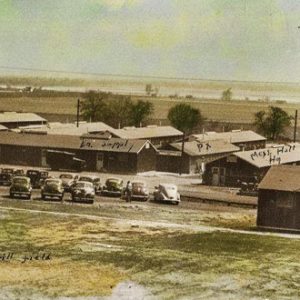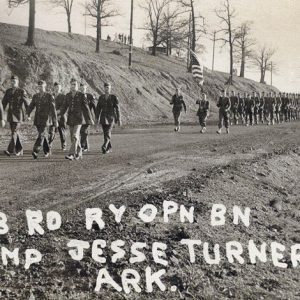calsfoundation@cals.org
Camp Jesse Turner
Camp Jesse Turner, located on Pickett Hill on the east side of Van Buren (Crawford County), was a small, specialized railroad training camp for soldiers to learn to operate railroads captured in enemy territory, worldwide, during World War II. It was briefly named Camp Walter Johnson, but on September 24, 1943, the press reported a name change to honor Jesse Turner, a justice on the Arkansas Supreme Court from the area. The soldiers assigned to four Railroad Operating Battalions (ROBs)—the 759th, 748th, 733rd, and 734th—were trained in the Missouri Pacific Railroad yards and roundhouse in Van Buren. Their weapons of war were locomotives, cars, tracks, bridges, telephone and telegraph lines, and repair shops.
In 1941, the federal government allocated funds to communities affected by defense projects to help them with additional costs required to increase their infrastructure in support of military installations. Citizens of Crawford County met on July 25 to draft requests in support of two proposed installations, the proposed railroad installation in Van Buren and an airfield in the Shibley, Oak Grove, and Catcher communities of Crawford County. The citizens strenuously opposed an airfield being located in the county’s most fertile agriculture area and successfully petitioned representatives in Washington DC to cancel that military base.
On July 15, 1942, the Department of War contracted with the widow of Dr. Lucas Giles to purchase thirty-five acres of land from his estate for the construction of Camp Jesse Turner. The urgency of war preparation can be discerned from the rapid course of events, as the site was surveyed by the U.S. Army Corps of Engineers and building material was unloaded on July 18. Thirty-four of the fifty-one non-insulated temporary buildings were hurriedly constructed.
Camp Jesse Turner was officially accepted by the Department of Transportation from the Corps of Engineers by Lieutenant Colonel E. F. Barnes on December 4, 1942. Col. Barnes, the commander, and other executive officers arrived early with an advance party of thirty-five to prepare for the arrival of 1,150 troops of the 759th Railway Operating Battalion on December 11.
When drafted into the military, the majority of the officers and soldiers assigned to the camp were technical railroad workers in civilian life. Each battalion comprised four distinct companies: the “H” and “S” company—headquarters and services—consisted of officers, clerks, medical personnel, and telegraph operators in support of a railroad line; Company “A” consisted of officers and troops in charge of building and maintaining the railroad tracks and bridges; Company “B” was formed of machinists and mechanical workers; and Company “C” was made up of the men to actually operate the railroad—engineers, firemen, conductors, and switchmen. Each battalion had medical personnel, including a doctor and a dentist, but soldiers requiring major medical treatment were sent to nearby Camp Chaffee (now Fort Chaffee).
The soldiers enjoyed close ties with local citizens, who welcomed them by providing and furnishing a recreation facility for them and inviting them to church, school, and civic functions. When possible, troops contributed funds to aid Crawford County in Red Cross bond drives; they also held parades, and the battalion bands toured the communities performing to raise funds for the war effort. The soldiers and camp site, located on high ground, played a pivotal role in the community when the 1943 spring floodwaters of the Arkansas River engulfed Van Buren, washing out the bridge linking Van Buren with Fort Smith (Sebastian County), washing out levees, and inundating low-lying crop lands.
Though the floodwaters severely damaged the railroad lines in Van Buren, the soldiers acted quickly to run trains around the flooded lines. Camp Jesse Turner also housed and fed many flood-stricken citizens. The delivery of the first and only baby at the camp was reported in May 1943. The departing troops of the 759th insisted on naming the baby Jesse Turner Rutledge.
By the middle of June 1943, 400 African-American soldiers from the 469th Quartermaster Truck Regiment at Camp Maxey, Texas, were bivouacked in tents on the grounds of Camp Jesse Turner. They were sent from their camp in Texas to reclaim the farmland in the flooded areas in time for fall planting.
The 759th departed Camp Jesse Turner on May 20, 1943, for overseas, where they merged with other railroad battalions in the campaigns of North Africa, Sicily, Italy, and southern France. The 748th ROB, which was activated near New Orleans, Louisiana, on May 19, 1943, arrived at Camp Jesse Turner before July for special training. They departed Van Buren in late October, for the China-Burma-India war theater. The 733rd Railroad Operating Battalion arrived in Van Buren in late November 1943; they departed in June 1944, arriving in France soon after the June 6, 1944, D-Day invasion. The last battalion assigned to Camp Jesse Turner, the 734th ROB, arrived before June 16, 1944, and departed late that year, arriving in France just before Christmas to assume operation of the rail lines in northern France. With the departure of the last battalion, the camp operation was phased down.
The economic impact upon the county was minimal when Camp Jesse Turner was closed, primarily because the economy was not significantly enhanced by the camp due to the limited number assigned and because one battalion shipped out before another one arrived. In the summer of 1946, a contract was let to a Fayetteville (Washington County) firm for the removal of the buildings to house veterans, and by 1949, part of the land was secured for the building of the Crawford County Hospital, with the government donating the land for the hospital and providing grant funds for much of the construction costs. The rest of the land housed a low-income housing project.
For additional information:
Kaufman, Dave. “748th Railway Operating Battalion.” Trading Post, October–December 1999, 11–19. Online at https://militaryrailwayservice.blogspot.com/2009/11/748th-rob-from-dave-kaufman.html?msclkid=e8aa46ebc65011ecb416dd921af5324a (accessed April 27, 2022).
Record Group 407, 748th Railway Operating Battalion. National Archives and Record Administration, Washington DC.
Roberts, Robert B. Encyclopedia of Historic Forts: The Military Pioneer and Trading Posts of the United States. New York: MacMillan Publishing Company, 1988.
Woolard, Mark A. The United States Army Installations of World War I and World War II (with Army Air Corps Fields and Bases). Carlisle, PA: United States Army War College, 1946.
Wanda M. Gray
Fort Smith, Arkansas
 Camp Jesse Turner
Camp Jesse Turner  Camp Jesse Turner
Camp Jesse Turner  Camp Jesse Turner Parade
Camp Jesse Turner Parade 




I’m a direct descendant of Jesse Turner.
My name is Jesse Turner Rutledge, and I was born on May 15, 1943. I am very proud to have been the only baby born at Camp Jesse Turner. My mother wanted to name me Ronald David, but the soldiers wanted me to be named Jesse Turner Rutledge. I left Arkansas in 1951 on a Greyhound bus with my mother Josephine and two sisters, Pat and Peggy. They are all deceased, and I miss them very much. The person I miss the most is my Granddaddy Lincks. He was the finest man I have ever known. A big part of me is still in Arkansas, and I still root for the Razorbacks and my favorite bird is the cardinal. Thank you so much for posting the information about Camp Jesse Turner.